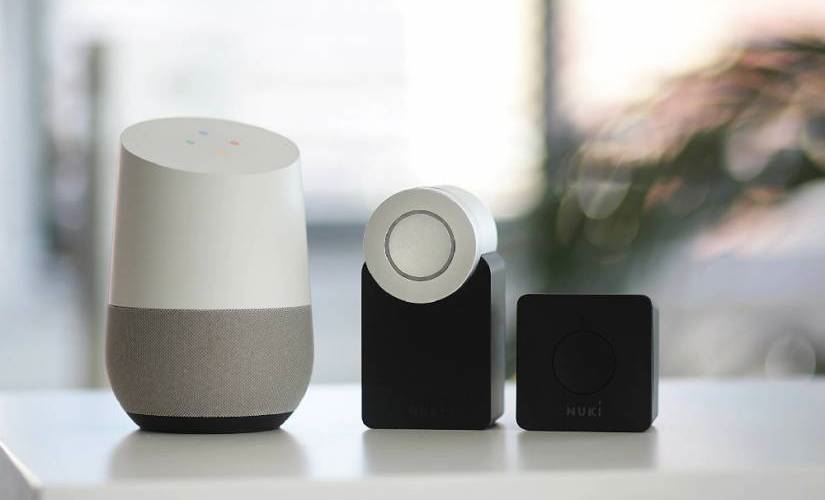7 Actionable Tips to Secure Your Smart Home and IoT Devices
7 Actionable Tips to Secure Your Smart Home and IoT Devices

As you welcome the Internet of Things (IoT) into your home, turning it into a “smart” home, you’re also likely making it an “insecure” home. Here are seven actionable tips to secure your smart home and IoT devices.
A more connected home makes your life easier and more efficient.
A more connected home makes your life easier. But with increased internet-based convenience comes an increased risk of becoming the target of cyberpunks. These hackers can steal and misuse your personal information and banking details, and even take control of those smart cameras or microphones to spy on you.
In other words, if you own smart devices such as smart speakers, TVs, thermostats, fridges, security cameras, and whatnot, your privacy and security could be at stake. Because, in essence, these are multiple entry points with rickety security that could leave you prone to attacks.
So, long story short, if you’re investing dough in setting up a smart home, you must also invest some time and energy in securing it. Here are seven ways to get started with that:
1. Set up Your Router Correctly
Your Wi-Fi router is the doorway to your smart home. You don’t want it to break down in case a cybercriminal kicks it.
And so, creating a more secure smart home starts with your router. It’s what connects all your IoT devices and makes them so valuable.
Follow these best practices to set up a secure router:
Change the Router’s Default Name
Don’t stick with your router’s default name, which is usually its make and model. If people discover the make and model, they may be able to look up the default login and password and get easy access to your smart home network.
So, change it to an unusual name that’s not associated with you or your address. Be creative with your router name but don’t give away any personal identifiers.
Set the Password to Something Unique
Similar to the router name, set the router’s password to something truly unique. Use complex passwords made up of letters, numbers, and symbols. Consider using a random password generator to generate a near-impenetrable password.
Use the Highest Level of Encryption
Finally, go for the highest level of encryption, which currently is WPA2 (WPA3 is just around the corner). If your router only supports the WPA or WEP protocols, maybe it’s time for an upgrade.
Home routers are primary IoT targets for hackers. Thus, a secure router translates to a substantially more secure smart home.
2. Use Super Strong Passwords
Apart from your Wi-Fi router’s password, there are other areas where you need to ensure you have a super-strong password. For instance, your IoT devices require you to create an account and sign in to use them. The devices usually have associated mobile apps where those login credentials are needed.
Now, it is important to create unique credentials for every IoT device’s account and app. This is so that if the password of one device gets compromised, others still remain intact.
The obvious downside is that you’ll have to remember many passwords, which is indeed a pain in the bum. If you write them down somewhere, make sure it’s squirreled away carefully. However, a better alternative to jotting down passwords in a secret diary is to use a password management tool, which can store unlimited unique passwords, create new ones, and even sync them between various devices.
3. Create a Separate Wi-Fi Network for IoT Devices
Many modern routers provide you the ability to set up a guest (or secondary) network. By creating a separate network dedicated to your IoT devices, you can safeguard your main network against IoT threats.
This means relatives, friends, and guests can log into a network that isn’t related to your IoT devices. So, your local smart home network is only accessible by you (and your family).
As putting IoT devices on a different network keeps them detached, if hackers do manage to get through, they can’t access any of your more important devices, such as your laptop or smartphone.
Ofer Maor, a cybersecurity thought leader and board member of the OWASP Foundation, says, “I run my home on multiple network segments. There is my ‘office’ network with the laptops, NAS, and all the important sensitive parts of my home. There is my ‘Home IoT’ network, which holds most of the IoT devices. This limits a breach — if one of my IoT devices gets hacked, the hacker may be able to propagate from it to other IoT devices but will not be able to reach my laptop or my sensitive data.”
4. Disable Features You Don’t Use
Many IoT devices give you the ability to control them from anywhere on the planet. But if you only use them on your home’s Wi-Fi connection, disable remote access. Likewise, smart speakers have Bluetooth connectivity in addition to Wi-Fi. Don’t use it? Turn it off.
Smart TVs come with voice control, but this feature often goes unused even in voice-controlled households where smart assistants such as Google Assistant, Siri or Alexa rule the roost. It may sound paranoid but an active mic, if hacked, can also be used to pry on your conversations.
Thus, disabling features is all about blocking as many of those multiple entry points as possible.
5. Keep Your Devices Up-To-Date
Updates to your Wi-Fi router’s firmware may not happen automatically. These updates often include essential security patches that can greatly enhance your network’s security.
See to it that you do a manual check every few months, and if you find any pending firmware updates, install them right away. In the same vein, many IoT devices (and their apps) don’t update automatically but prompt you to do so whenever available. Again, don’t procrastinate — update straight away.
6. Enable Multi-Factor Authentication
If you’ve ever used net banking, you know what multi-factor authentication is. Multi, typically two, -factor authentication (2FA), is an added layer of security beyond a mere password. With two-factor authentication, every time someone tries to log in to your IoT device, they have to provide additional proof of identity.
Your proof can come in the form of a one-time pin (OTP) or a verification code sent to your phone or email address that confirms that the person logging in is indeed you.
Most smart devices have the multi-factor authentication feature by default, but there are some devices that don’t. In that case, you can enable 2FA by using third-party apps such as Google Authenticator.
Even if your IoT device has two-factor authentication with its associated mobile app, having an extra layer of security via a trusted third-party service can give you further peace of mind.
7. Employ a Next-Generation Firewall (NGFW)
While your router has a built-in firewall — it may not prove to be sufficient. Because a traditional firewall lacks important security features like an intrusion prevention system (IPS), malware protection, content filtering, SSL/SSH interception, QoS management, and virtual private network (VPN).
A next-generation firewall (NGFW) is an integrated network platform that combines a traditional firewall with other security functionalities such as the ones just mentioned. An NGFW has all the capabilities of a traditional firewall as well, making it powerful in detecting and protecting against cyberattacks.
Next-generation firewalls are a fairly expensive investment, but the level of security boost for your smart home makes it a worthy investment. After all, if you can afford the devices, you can surely spend a little extra to secure them. By doing so, you’re securing your privacy.
The Ball is in Your Court
You can purchase the most expensive IoT devices from top companies, and yet, at the end of the day, your smart home’s security is in your hands.
So, take the time to do your research before committing to any device. Check if it’s still receiving updates from the manufacturer or if it has vulnerabilities reported by users. Yes, it takes time and money, but it’s always better to be safe than sorry.
The post 7 Actionable Tips to Secure Your Smart Home and IoT Devices appeared first on ReadWrite.
(36)


